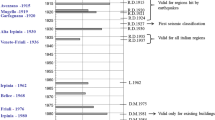Abstract
The earthquake sequence started on May \(20\)th 2012 in Emilia (Italy) affected a region where masonry constructions represent a large part of the existing building stock and the construction of new modern masonry buildings is a common practice. The paper is focused on the performance of common architectural configurations, typical for residential or business use. The large majority of old masonry buildings is made of fired clay bricks. The seismic performance of these buildings is particularly interesting since major past earthquakes in Italy affected areas with mainly stone masonry structures. Apart from examples showing systematic or peculiar structural deficiencies governing the vulnerability of several buildings, the overall seismic performance of these structures to repeated shaking, with PGA as large as 0.25–0.3 g was rather good, despite the major part of them were only conceived for carrying vertical loads. In fact, seismic design is mandatory in the area only since 2003. Modern low-rise masonry buildings erected after this date and incorporating seismic design and proper detailing resulted in most cases practically undamaged. The examples reported in the paper allow an evaluation of the superior performance of seismically designed modern masonry buildings in comparison to older ones.



















Similar content being viewed by others
References
Arcoraci L, Berardi M, Bernardini F, Brizuela B, Caracciolo CH, Castellano C, Castelli V, Cavaliere A, Del Mese S, Ercolani E, Graziani L, Maramai A, Massucci A, Rossi A, Sbarra M, Tertulliani A, Vecchi M, Vecchi S (2012) Rapporto macrosismico sui terremoti del 20 \((\text{ M }_{\rm l}\,5.9)\) e del 29 maggio 2012 \((\text{ M }_{\rm l}\,\text{5.8 } \text{ e } \text{5.3 })\) nella pianura Padano-Emiliana, QUEST-INGV. available from www.ingv.it (in Italian)
Beyer K, Dazio A (2012) Quasi-static cyclic tests on masonry spandrels. Earthquake Spectra 28(3):907–929
Bozzoni F, Lai CG, Scandella L (2012) Preliminary results of ground-motion characteristics. Ann Geophys 55(4):609–614
Bozzoni F, Lai CG (2012) Personal communication
Breventano S, (1576) Trattato del terremoto, 2007 edition by Paola Albini. IUSSPress, Pavia (in Italian)
D’Ayala D, Paganoni S (2011) Assessment and analysis of damage in L’Aquila historic city centre after 6th April 2009. Bull Earthq Eng 9(1):81–104
Guidoboni E, Ferrari G, Mariotti D, Comastri A, Tarabusi G, Valensise G (2007) CFTI4Med, Catalogue of Strong Earthquakes in Italy (461 B.C.-1997) and Mediterranean Area (760 B.C.-1500). INGV-SGA. http://storing.ingv.it/cfti4med/
ISTAT (2001) Italian census data, available at dawinci.istat.it
Javed M, Khan AN, Penna A, Magenes G (2006) Behaviour of masonry structures during the Kashmir 2005 earthquake, In: Proceedings of first European conference on earthquake engineering and seismology, Geneva, Switzerland, Paper No. 1077
OPCM 3274 (2003) Ordinanza del Presidente del Consiglio dei Ministri n. 3274 del 20 marzo 2003 “Primi elementi in materia di criteri generali per la classificazione sismica del territorio nazionale e di normative tecniche per le costruzioni in zona sismica”, S.O. n. 72, G.U. n.105 del 8 maggio 2003, Annex 1 (in Italian)
Rota M, Penna A, Strobbia C, Magenes G (2011) Typological seismic risk maps for Italy. Earthquake Spectra 27(3):907–926
Saatcioglu M, Bruneau M (1993) Performance of structures during the 1992 Erzincan earthquake. Can J Civ Eng 20:305–325
Sorrentino L, Liberatore L, Liberatore D, Masiani R (2013) The behaviour of vernacular buildings in the 2012 Emilia earthquakes. Bull Earthq Eng. doi:10.1007/s10518-013-9455-2
Sucuoglu H, Erberik A (1997) Performance evaluation of a three-storey unreinforced masonry building during the 1992 Erzincan earthquake. Earthq Eng Struct Dyn 26:319–336
Toscani G, Burrato P, Di Bucci D, Seno S, Valensise G (2009) Plio-Quaternary tectonic evolution of the Northern Apennines thrust fronts (Bologna-Ferrara section, Italy): seismotectonic implications. Bollettino della Società Geologica Italiana 128(2):605–613
Acknowledgments
The authors would like to acknowledge the contribution of Stefano Bracchi, Alessandro Galasco and Michele Palmieri, who voluntarily participated to the surveys, also providing a fundamental contribution to the Civil Protection Department for the post-earthquake damage survey, and the help of Francesco Graziotti, who also contributed to the critical discussion on the observed damages and Martina Mandirola and Annalisa Rosti who also helped in the organisation of the collected information. Sincere thanks are finally due to Francesca Bozzoni and Prof. Carlo Lai, for providing the estimated values of peak ground acceleration experienced at the sites where the different considered damaged buildings were located.
Author information
Authors and Affiliations
Corresponding author
Rights and permissions
About this article
Cite this article
Penna, A., Morandi, P., Rota, M. et al. Performance of masonry buildings during the Emilia 2012 earthquake. Bull Earthquake Eng 12, 2255–2273 (2014). https://doi.org/10.1007/s10518-013-9496-6
Received:
Accepted:
Published:
Issue Date:
DOI: https://doi.org/10.1007/s10518-013-9496-6




